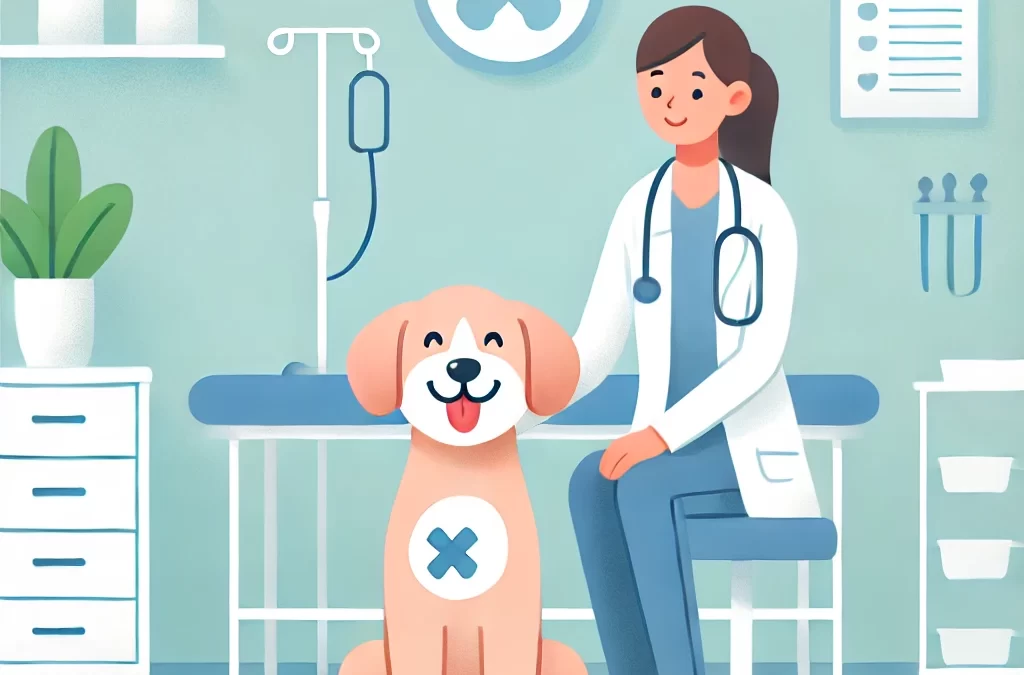
por TCMVET | 27 de novembro de 2024 | Câncer e tumores caninos
Tigilanol tiglate, um tratamento inovador para certos tipos de tumores caninos, tem sido um divisor de águas na oncologia veterinária. À medida que os donos de animais exploram essa terapia inovadora, muitos estão preocupados com seu custo. Mas a conversa sobre custo vai além do valor monetário? Vamos mergulhar em uma perspectiva única sobre o valor do tiglanol tiglate — olhando não apenas para o que ele custa, mas para o que ele oferece em troca.
Compreendendo o Tigilanol Tiglate
Desenvolvido a partir das sementes da árvore blushwood, o tigilanol tiglate (comercializado como Stelfonta®) oferece uma solução não cirúrgica para tumores de mastócitos em cães. Administrado por injeção, ele funciona destruindo células tumorais e estimulando a cicatrização de feridas, geralmente com resultados visíveis em poucos dias. Esta terapia inovadora é particularmente atraente para cães que não são candidatos à cirurgia devido à idade, saúde ou localização do tumor.
Os Custos Financeiros
O preço do tigilanol tiglato pode variar muito, dependendo de vários fatores:
- Tamanho do tumor
O medicamento tem preço baseado na dosagem, que é determinada pelo volume do tumor. Tumores maiores exigem doses maiores, aumentando o custo.
- Honorários veterinários
O custo da administração inclui avaliações pré-tratamento, sedação, o procedimento em si e cuidados de acompanhamento. Essas taxas profissionais podem variar de acordo com o local e a clínica.
- Cuidados pós-tratamento
Embora muitos cães se recuperem rapidamente, alguns podem precisar de tratamento adicional para feridas, o que pode aumentar o custo geral.
Em média, o custo do tratamento com tigilanol tiglato varia de $500 a $2.500 ou mais, dependendo dos fatores acima.
Os Custos Emocionais
Embora as despesas financeiras sejam significativas, o ônus emocional de tratar um animal de estimação querido também deve ser considerado. O tiglate de tigilanol oferece uma alternativa atraente à cirurgia invasiva, reduzindo o estresse e o tempo de recuperação para os animais de estimação e seus donos.
- Menos ansiedade para seu cão
A cirurgia geralmente envolve períodos de recuperação mais longos e riscos mais altos, particularmente para cães mais velhos. O tiglato de tigilanol minimiza esses desafios, oferecendo uma solução menos invasiva.
- Tranquilidade para os Proprietários
Assistir a um tumor encolher em tempo real pode ser uma experiência emocionalmente gratificante. Para muitos, o custo é justificado pelos resultados visíveis e imediatos.
Custo vs. Valor
Ao avaliar o preço do tiglato de tigilanol, é essencial considerar seu valor:
- Qualidade de vida: O tratamento se concentra em preservar e melhorar o bem-estar do cão sem os riscos associados à cirurgia.
- Tempo economizado: Com uma única injeção, o tratamento geralmente elimina a necessidade de longos períodos de recuperação.
- Alívio emocional: A capacidade de ver uma melhora rápida pode ser inestimável para donos de animais de estimação que lutam com o fardo do diagnóstico de seus cães.
Poupança Oculta
Embora os custos iniciais possam parecer altos, o tiglato de tigilanol pode oferecer economias indiretas:
- Evitar complicações relacionadas à cirurgia e seus custos associados.
- Necessidade reduzida de tratamentos contínuos ou medicamentos para controle do tumor.
- Prevenção de futuros problemas relacionados a tumores por meio de intervenção precoce.
Como comprar Tigilanol Tiglate: Dicas para donos de animais de estimação
Para aqueles preocupados com a acessibilidade, aqui estão algumas dicas para explorar:
- Pet Insurance: Verifique se sua apólice cobre tratamentos avançados como tigilanol tiglato.
- Payment Plans: Muitas clínicas veterinárias oferecem planos de parcelamento para ajudar a gerenciar os custos.
- Assistência sem fins lucrativos: Organizações dedicadas ao cuidado de animais de estimação às vezes fornecem ajuda financeira para tratamentos críticos.
- Orçamento antecipado: O planejamento financeiro antecipado para os cuidados de saúde do seu animal de estimação pode aliviar o fardo de despesas inesperadas.
Pensamentos finais
O custo do tiglato de tigilanol não é apenas um número — é uma medida de esperança, inovação e cuidado. Embora o tratamento possa não se adequar a todos os orçamentos, ele oferece valor incomparável para cães e suas famílias, fornecendo uma opção minimamente invasiva e eficaz para o tratamento de tumores de mastócitos. Para muitos, a questão não é apenas "Quanto custa?", mas sim "Qual é o custo de não tentar?"
Conforme você navega na jornada de tratamento do seu cão, lembre-se de que o preço do cuidado inclui não apenas os dólares gastos, mas também os momentos que vocês ganham juntos. O tiglate de tigilanol representa um futuro em que mais cães podem viver vidas mais saudáveis e felizes — um investimento em amor, longevidade e companheirismo.

por TCMVET | 27 de novembro de 2024 | Câncer e tumores caninos
Decidir quando dizer adeus a um cão querido diagnosticado com câncer é uma das decisões mais difíceis que qualquer dono de animal de estimação enfrentará. Embora cada caso seja único, este artigo oferece uma perspectiva alternativa sobre este tópico emocionalmente carregado — focando no amor, na qualidade de vida e na criação de memórias significativas antes de deixar ir.
Compreendendo a jornada do seu cão
Cães com câncer, assim como humanos, vivenciam uma gama de estados físicos e emocionais. Entender a condição deles pode ajudar você a tomar decisões informadas:
- Níveis de dor: Dor é frequentemente o primeiro indicador. Apesar dos avanços em cuidados paliativos, alguns cães podem sentir desconforto persistente.
- Problemas de mobilidade: Observe se seu cão ainda consegue aproveitar atividades como caminhar ou brincar. Perda de mobilidade pode significar um declínio em sua qualidade de vida.
- Mudanças no apetite: Uma recusa repentina de comer ou beber pode significar que seu corpo está desligando.
- Mudanças emocionais: Cães são criaturas emocionais. Observe se seu cão parece retraído, ansioso ou desinteressado em seus arredores.
Uma nova estrutura: a abordagem das “Cinco alegrias”
Em vez de focar somente no declínio, considere esta abordagem para avaliar a qualidade de vida do seu cão. Pergunte a si mesmo:
- Comendo: Seu cachorro ainda gosta de suas comidas favoritas?
- Dormindo confortavelmente: Eles estão descansando sem sinais de dor ou sofrimento?
- Interação social: Eles buscam companhia ou gostam de ser acariciados?
- Jogando: Eles estão envolvidos em suas atividades favoritas, mesmo que de forma limitada?
- Explorando: Eles demonstram interesse no ambiente em que vivem?
Quando três ou mais dessas alegrias estão constantemente ausentes, pode ser hora de considerar a eutanásia.
Dizer adeus: uma abordagem holística
Dizer adeus não precisa parecer o fim abrupto de um capítulo. Aqui estão algumas maneiras de honrar a jornada do seu cão enquanto facilita a transição:
- Crie uma lista de desejos
Comemore a vida do seu cão criando momentos de alegria. Pode ser algo simples como um piquenique no parque favorito dele ou compartilhar um mimo especial.
- Foco no conforto
Forneça um ambiente calmo e familiar. Use roupas de cama aconchegantes, massagens suaves e aromaterapia para aliviar o estresse deles.
- Comunique-se com um veterinário de sua confiança
Um veterinário compassivo pode orientá-lo a reconhecer os sinais de declínio e ajudá-lo a planejar uma morte tranquila.
- Considere a eutanásia em casa
Muitos donos de animais de estimação optam por serviços de eutanásia em casa, permitindo que seus cães morram em ambientes familiares, cercados por entes queridos.
- Preserve o legado deles
Crie uma lembrança, como um molde de pegada de pata ou um álbum de recortes de fotos queridas. Isso pode ajudar você a processar o luto enquanto celebra a vida do seu cão.
Redefinindo o adeus final
A eutanásia não é apenas uma decisão clínica — é um ato de amor. Ao escolher deixar seu cão ir em paz, você está poupando-o de sofrimento desnecessário e honrando sua dignidade. Em vez de focar em "quando deixar ir", mude sua perspectiva para "como tornar seus últimos momentos significativos".
Conclusão: Não há problema em sofrer
O luto é uma parte natural do processo. É uma prova do vínculo profundo que você compartilhou com seu cão. Procure apoio de amigos, familiares ou até mesmo comunidades online de amantes de animais de estimação que entendam o que você está passando.
No final, a decisão é profundamente pessoal. Confie nos seus instintos, honre a jornada única do seu cão e saiba que o amor, não o tempo, define seu relacionamento com seu animal de estimação.

por TCMVET | 26 de novembro de 2024 | Câncer e tumores caninos
Quando um tutor de animal de estimação ouve a palavra “tumor”, é como um soco no estômago. As perguntas vêm à tona: É cancerígeno? Meu cachorro ficará bem? E o mais importante, O que posso fazer para ajudar? Embora a medicina veterinária moderna ofereça vários tratamentos, muitos donos estão se voltando para abordagens naturais e holísticas para complementar os cuidados tradicionais. Vamos explorar algumas opções inovadoras e menos conhecidas para ajudar a controlar e potencialmente diminuir tumores em cães.
A Natureza dos Tumores em Cães
Tumores em cães podem variar de lipomas benignos a cânceres malignos como tumores de mastócitos ou osteossarcomas. O plano de tratamento depende do tipo, tamanho e estágio do tumor, mas lidar com ele geralmente envolve uma mistura de tratamentos convencionais (como cirurgia ou quimioterapia) e terapias de suporte para melhorar a saúde geral.
Mas aqui está o problema: nem todos os tratamentos precisam ser invasivos ou sintéticos. A natureza nos forneceu um tesouro de recursos que podem ajudar a diminuir tumores enquanto apoiam o bem-estar do seu cão.
Suporte Nutricional: Alimentos como Medicina
- Potências dos cogumelos
Cogumelos medicinais como shiitake, reishi, e rabo de peru são ricos em beta-glucanos, que podem ajudar a regular o sistema imunológico e podem retardar o crescimento do tumor. Estudos em oncologia veterinária sugerem que esses fungos podem reduzir a progressão de certos tipos de câncer. Uma pitada de suplementos de cogumelos em pó na comida do seu cão pode mudar o jogo.
- Pasta Dourada (Mistura de Cúrcuma)
A cúrcuma é conhecida por seu composto ativo, curcumina, um poderoso anti-inflamatório e antioxidante. A curcumina demonstrou interromper o crescimento de células cancerígenas em alguns estudos. Misture pó de açafrão com óleo de coco e pimenta-do-reino para criar uma pasta dourada, adequada para cães.
- Ácidos gordurosos de omega-3
Encontrados no óleo de peixe ou na semente de linhaça, os ômega-3 são anti-inflamatórios naturais que podem retardar o crescimento de tumores e dar suporte à saúde geral. Adicione-os às refeições do seu cão para um reforço alimentar simples, mas impactante.
Suplementos naturais para o tratamento de tumores
- Óleo CBD
O canabidiol (CBD) ganhou força por seus potenciais efeitos antitumorais. Acredita-se que ele induza apoptose (morte celular programada) em células cancerígenas e reduza a inflamação. Escolha sempre um óleo de CBD específico para animais de estimação que seja livre de THC e consulte seu veterinário para a dosagem correta.
- Chá Essiac
Uma mistura de ervas, incluindo raiz de bardana, olmo escorregadio e azedinha, o chá Essiac tem sido usado há muito tempo como um remédio natural para tumores. Ele está disponível em forma líquida ou em cápsulas e acredita-se que ajude a desintoxicar o corpo e a diminuir crescimentos anormais.
- Chuanxiong (Livo-de-sichuan)
Uma erva chinesa tradicional menos conhecida, mas potente, Chuanxiong tem propriedades que melhoram a circulação e reduzem a inflamação. Alguns veterinários holísticos a recomendam como parte de um protocolo herbal para o tratamento de tumores.
Terapias Holísticas
- Acupuntura
Embora não diminua diretamente os tumores, a acupuntura pode melhorar o fluxo sanguíneo, reduzir a dor e aumentar a eficácia de outros tratamentos. É uma ótima adição a um plano de cuidados multifacetado.
- Terapia de oxigênio hiperbárico (OHB)
Tumores prosperam em ambientes com pouco oxigênio. A terapia de oxigênio hiperbárico satura o corpo com oxigênio, potencialmente desacelerando o crescimento do tumor e auxiliando na cura.
Ajustes no estilo de vida
- Revisão Dietética
Uma dieta baixa em carboidratos e alta em proteínas pode matar de fome certos tumores que dependem de açúcar para crescer. Considere uma dieta crua ou cozida adaptada às necessidades específicas do seu cão.
- Redução do estresse
O estresse crônico pode suprimir o sistema imunológico, tornando mais difícil para seu cão combater doenças. Garanta que o ambiente do seu cão seja calmo e enriquecido com atividades que ele goste.
- Desintoxicando o meio ambiente
Reduza a exposição a produtos químicos nocivos como pesticidas, purificadores de ar sintéticos e alimentos processados. Essas toxinas ambientais podem sobrecarregar o sistema do seu cão, tornando a recuperação mais desafiadora.
O poder de combinar abordagens modernas e naturais
Embora as terapias naturais ofereçam benefícios incríveis, elas não são uma solução autônoma para todos os cães. A parceria com um veterinário que entenda o cuidado integrativo é crucial. Isso garante que seu cão receba o melhor dos dois mundos: o poder salvador da medicina moderna e o suporte gentil dos remédios naturais.
Uma perspectiva esperançosa
A jornada de ajudar seu cão a passar por um diagnóstico de tumor pode parecer assustadora, mas lembre-se: você não está sozinho. Com uma mistura de mudanças alimentares, suplementos naturais e terapias holísticas, você pode dar ao seu cão uma chance de lutar enquanto melhora sua qualidade de vida.
Às vezes, as menores mudanças — uma pitada de açafrão, uma colher de pó de cogumelo ou uma gota de CBD — podem fazer a maior diferença.

por TCMVET | 26 de novembro de 2024 | Alimentação e Saúde
Como donos de animais de estimação, buscamos constantemente maneiras de melhorar o bem-estar dos nossos cães. Embora suplementos tradicionais como óleo de peixe ou glucosamina sejam amplamente usados, uma opção única que está ganhando popularidade é pó de cogumelo shiitake. Este antigo superalimento, tradicionalmente reverenciado na culinária e medicina asiáticas, está chegando ao mundo do bem-estar animal com benefícios promissores. Vamos nos aprofundar no motivo pelo qual o pó de cogumelo shiitake pode ser a próxima virada de jogo para seu amigo peludo.
O que é pó de cogumelo Shiitake?
Os cogumelos shiitake (Lentinula edodes) são um tipo de fungo comestível conhecido por seu rico sabor umami e potentes propriedades de saúde. Quando moído em um pó fino, este ingrediente se torna um suplemento versátil que pode ser facilmente adicionado às refeições do seu cão. Cheios de nutrientes essenciais como vitaminas B e D, selênio, cobre e polissacarídeos, os cogumelos shiitake são muito mais do que apenas uma delícia culinária.
Os surpreendentes benefícios para a saúde dos cães
O pó de cogumelo shiitake não é apenas uma adição da moda; ele é apoiado pela ciência. Aqui estão algumas maneiras pelas quais ele pode melhorar a saúde do seu cão:
- Suporte ao sistema imunológico
Os cogumelos shiitake contêm beta-glucanos, compostos conhecidos por suas propriedades de reforço imunológico. Eles ajudam a fortalecer as defesas do seu cão contra infecções e doenças, tornando-os especialmente benéficos para cães idosos ou aqueles com sistemas imunológicos enfraquecidos.
- Propriedades Antiinflamatórias
Se seu cão sofre de artrite, alergias ou outras condições inflamatórias crônicas, os compostos naturais dos cogumelos shiitake podem ajudar a reduzir a inflamação e promover conforto.
- Potência antioxidante
Ricos em antioxidantes como o selênio, os cogumelos shiitake combatem o estresse oxidativo em cães, o que pode retardar o envelhecimento e reduzir o risco de doenças crônicas.
- Saúde digestiva
As fibras prebióticas presentes nos cogumelos shiitake promovem a saúde intestinal ao alimentar bactérias benéficas, melhorar a digestão e ajudar na absorção de nutrientes.
- Prevenção e apoio ao câncer
O pó de cogumelo shiitake está ganhando atenção por suas potenciais propriedades anticâncer, particularmente devido a compostos como lentinan. Embora não seja uma cura, pode ser uma terapia complementar para cães que lutam contra tumores.
Como introduzir pó de cogumelo Shiitake ao seu cão
- Comece pequeno
Comece com uma pequena quantidade (cerca de 1/4 de colher de chá para cães pequenos e 1/2 colher de chá para cães maiores) misturada à comida deles. Aumente gradualmente conforme seu cão se ajusta.
- Escolha pó de alta qualidade
Certifique-se de usar um produto formulado especificamente para animais de estimação. Pós orgânicos, sem pesticidas e minimamente processados são os melhores.
- Observar e ajustar
Monitore seu cão para quaisquer alterações na digestão ou comportamento. Embora raro, alguns cães podem ter sensibilidade a cogumelos.
O Bônus Ético: Sustentabilidade
Usar pó de cogumelo shiitake está alinhado com práticas ecologicamente corretas. O cultivo de cogumelos requer o mínimo de água e terra, o que o torna uma escolha sustentável. À medida que mais donos de animais de estimação adotam estilos de vida ambientalmente conscientes, adicionar pó de shiitake à dieta do seu cão pode ser um pequeno passo em direção a um futuro mais verde.
Quebrando mitos: cogumelos são seguros para cães?
Muitos donos de animais hesitam quando ouvem “cogumelo” devido a preocupações com toxicidade. Embora seja verdade que alguns cogumelos selvagens são perigosos, variedades cultivadas como shiitake são perfeitamente seguras para cães quando administradas com moderação. Como sempre, consulte seu veterinário antes de introduzir qualquer novo suplemento.
Receitas de Shiitake em pó para cães
Para tornar a hora das refeições mais emocionante, aqui estão algumas maneiras simples de incorporar pó de cogumelo shiitake na dieta do seu cão:
- Polvilhar Shiitake: Polvilhe uma pitada de pó sobre a ração normal ou comida úmida do seu cão.
- Pasta Dourada: Misture pó de shiitake com açafrão, óleo de coco e água para um reforço anti-inflamatório.
- Guloseimas caseiras: Asse biscoitos para cães usando farinha de aveia, manteiga de amendoim e uma colher de chá de pó de shiitake.
Conclusão: Um superalimento para supercães
O pó de cogumelo shiitake é mais do que apenas um suplemento; é uma abordagem holística ao bem-estar canino. Desde aumentar a imunidade até apoiar a saúde intestinal, seus benefícios naturais podem complementar a dieta do seu cão de uma forma que poucos outros suplementos podem.
Então por que não sair do comum e experimentar esse superalimento único? Seu cão pode agradecer com um rabo abanando e uma vida mais saudável.
por TCMVET | 25 de novembro de 2024 | Alimentação e Saúde
Peptídeos polissacarídeos (PSPs), derivados de cogumelos medicinais, há muito são elogiados por seus notáveis benefícios à saúde em humanos. Agora, seu potencial como um suplemento inovador para a saúde canina está ganhando atenção. O PSP celular, uma forma concentrada desses compostos poderosos, oferece uma abordagem holística para aumentar a imunidade, combater doenças crônicas e melhorar o bem-estar geral em cães.
O que é PSP celular?
O PSP celular é um composto bioativo derivado de cogumelos medicinais como Trametes versicolor (cauda de peru) e Ganoderma lucidum (Reishi). Ele combina polissacarídeos e peptídeos, que trabalham sinergicamente para fornecer benefícios imunomoduladores, anti-inflamatórios e antioxidantes. Essas propriedades o tornam uma adição valiosa ao regime de saúde de cães que lidam com doenças crônicas, câncer ou condições relacionadas ao sistema imunológico.
Como o PSP celular beneficia os cães
Suporte ao sistema imunológico
O PSP celular é um modulador imunológico natural, ajudando a regular e fortalecer as defesas imunológicas do seu cão. É particularmente benéfico para cães com:
- Câncer: Ao aumentar a atividade das células assassinas naturais (NK) e estimular os glóbulos brancos, ajuda o corpo a combater tumores.
- Infecções crônicas: o PSP celular auxilia no combate a infecções persistentes, aumentando a resposta imunológica.
Propriedades anticâncer
Estudos sobre PSP mostraram resultados promissores na redução do crescimento tumoral e na melhora das taxas de sobrevivência. Para cães, isso significa:
- Retardando a progressão de cânceres como linfoma, osteossarcoma e tumores de mastócitos.
- Reduzir os efeitos colaterais da quimioterapia, como fadiga e imunidade enfraquecida.
Efeitos antiinflamatórios
A inflamação crônica é a causa raiz de muitas doenças em cães, incluindo artrite e distúrbios gastrointestinais. O PSP reduz a inflamação no nível celular, proporcionando alívio de:
- Dor e rigidez nas articulações.
- Problemas digestivos, como doença inflamatória intestinal (DII).
Proteção Antioxidante
As propriedades antioxidantes do PSP celular neutralizam os radicais livres, prevenindo danos celulares e apoiando a saúde geral. Isso é particularmente valioso para cães idosos, pois ajuda a mitigar os efeitos do estresse oxidativo, que pode levar a doenças relacionadas à idade.
O PSP celular é adequado para seu cão?
Embora os benefícios do Cellular PSP sejam extensos, é essencial consultar um veterinário antes de introduzi-lo na dieta do seu cão. Cães com condições de saúde específicas ou passando por quimioterapia podem exigir dosagens personalizadas para resultados ideais. Além disso, sempre escolha suplementos de PSP de fontes confiáveis para garantir pureza e eficácia.
Conclusão
O PSP celular representa uma abordagem de ponta para o bem-estar canino, preenchendo a lacuna entre as terapias naturais e a ciência moderna. Ao apoiar a imunidade, reduzir a inflamação e fornecer proteção antioxidante, este suplemento poderoso pode melhorar a qualidade de vida do seu cão. Seja usado como uma medida preventiva ou como parte de um plano de tratamento mais amplo, o PSP celular oferece esperança e cura holística para cães de todas as idades.




